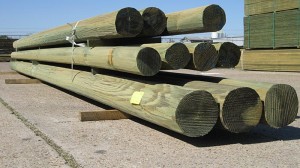
Green = CCA
9 times out of 10 green treated wood simply means CCA treated wood. CCA, of course, is Chromated Copper Arsenate, the stuff that was banned for use in most residential applications such as decks, railing, fences, and the like.
People freaked out about the “arsenate” component of the wood. Arsenate is a naturally-occurring form of arsenic so people got freaked out but the stuff is all around us anyway. Stick your hand in any patch of dirt in your backyard and you’ll probably be touching more arsenate than if you were to do a handstand on your CCA treated deck (which you can’t make anymore). I’ve researched it a decent amount and have seriously never seen any evidence that it actually causes any health issues. Oh, yeah. I digress…
CCA is still allowed for use in water and for many commercial and industrial applications because it is an ultra-effective treatment to dramatically increase the life of wood. Wood treated with CCA gets a green color that might range anywhere from light young-lemony-green with light treatment to near-forest green with a saltwater treatment (2.5pcf).
It’s that simple, really. Green treated wood is wood pressure treated with CCA.
Other Treatments
To separate themselves from the green treated wood, ACQ treated lumber producers branded their ACQ treated wood lumber as Yellawood, which you’ve probably seen on everything from store shelves to billboards. MCQ is basically clear, or colorless. In fact, the very strength of being clear is kind of its weakness, too, because when MCQ lumber is delivered many people do not believe they have received treated wood. It really is that hard to tell sometimes.
CCA is a better product anyway. I think we should drop the Yella stuff and the clear stuff and the whatever stuff and go back to the good ol’ green treated wood that works so well. It makes me want to only build on water where I know I can use the good stuff.
Of course, there’s also BLUE treated wood which is usually a borate-based treated wood but that’s a different conversation. 🙂
CCA was voluntarily removed from being used in residential applications. There was not any research to prove that is was harmful.
You can still find CCA beng used for telephone poles, plywood, wood foundations and other industrial/agricultural applications.
Some customers like the look of MCQ because it does not have the green look of typical pressure treated lumber.
agreed. Thanks for adding.
CAN YOU STAIN GREEN WOOD TO HIDE THE GREEN COLOR. FOR INSTANCE ANTHONY POWER GLULAM BEANS THAT HAVE A COPGUARD TREATMENT. THEY COME GREEN, CAN THAT COLOR BE HIDDEN W STAIN, AND STILL HAVE A WOOD LIKE APPEARANCE?
By “green”, you mean treated, right? In lumber, “green” often means undried and untreated — so, maybe still “wet” but just because it’s fresh.
Let’s go with treated… Yes, you can stain it but the wood needs to be dry first. After it dries, stain it with something dark enough to hide the green color. Time to dry depends on humidity, rain, temperature, sun shine, wind, and more but you should probably give it 4 to 6 weeks.